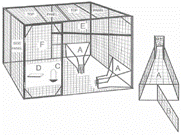Eastern Wildlife Damage Control Conferences

Eastern Wildlife Damage Management Conference: 8th (1997)
Date of this Version
October 1997
Document Type
Article
Abstract
Great-tailed grackle (Quiscalus mexicanus) damage to citrus is a serious concern to producers in the lower Rio Grande Valley of Texas. Damage caused by grackles pecking fruit is initiated by breeding colonies in the spring on immature fruit and extends through the fall and winter on ripening fruit. The most significant damage occurs during the post-breeding period of July through September when neither the currently registered DRC-1339-treated dog food bait nor frightening strategies are effective. Observations by Texas Wildlife Services personnel suggested that watermelon was highly attractive to grackles during the period when dog food baits are poorly accepted. Two control strategies using watermelon to bait large cage traps and to formulate DRC-1339 baits were evaluated in cage and field trials during a 2-year research project. This paper reports on the development and preliminary evaluations of a unique trap design and the 0.1% DRC-1339-treated watermelon bait. Summer field trials in citrus groves were conducted to evaluate the effectiveness and safety of trapping and DRC-1339 baiting. Results of preliminary evaluations clearly demonstrated the utility of these methods for controlling grackles. Although the effectiveness of these methods for controlling grackle damage in citrus groves was less conclusive, no measurable hazards to non-target wildlife were documented. With suggested modifications, both methods may provide a viable means to reduce grackle damage to citrus during a period when other alternative methods are ineffective.


Comments
Published in Proceedings of the Eighth Eastern Wildlife Damage Management Conference, Roanoke, Virginia, October 16–19, 1997, edited by James A. Parkhurst. Copyright © 1997 by the authors.